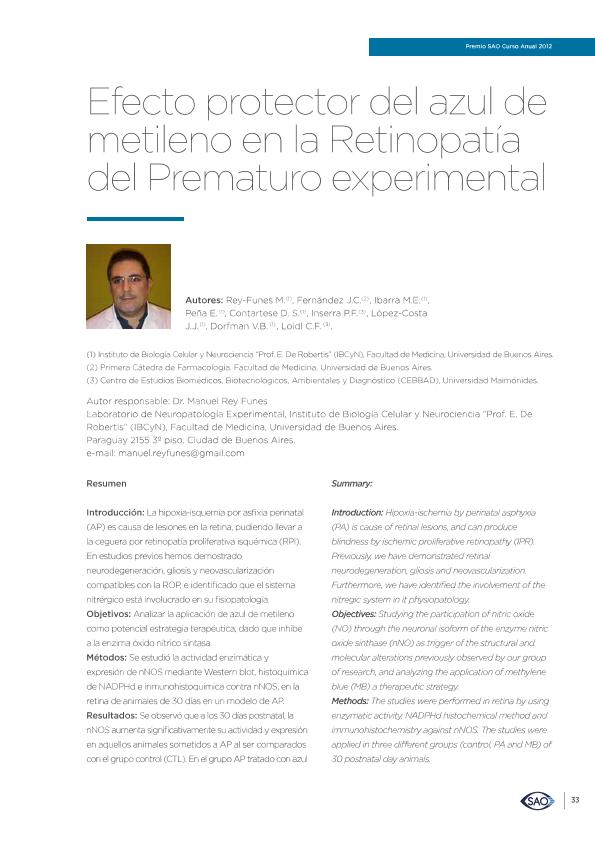Artículo
Introducción: La hipoxia-isquemia por asfixia perinatal (AP) es causa de lesiones en la retina, pudiendo llevar a la ceguera por retinopatía proliferativa isquémica (RPI). En estudios previos hemos demostrado neurodegeneración, gliosis y neovascularización compatibles con la ROP, e identificado que el sistema nitrérgico está involucrado en su fisiopatología. Objetivos: Analizar la aplicación de azul de metileno como potencial estrategia terapéutica, dado que inhibe a la enzima óxido nítrico sintasa. Métodos: Se estudió la actividad enzimática y expresión de nNOS mediante Western blot, histoquímica de NADPHd e inmunohistoquímica contra nNOS, en la retina de animales de 30 días en un modelo de AP. Resultados: Se observó que a los 30 días postnatal, la nNOS aumenta significativamente su actividad y expresión en aquellos animales sometidos a AP al ser comparados con el grupo control (CTL). En el grupo AP tratado con azul de metileno (AZM) no se encontraron diferencias significativas en la actividad de NOS constitutiva con respecto al grupo CTL, mientras que su expresión evaluada por western blot fue menor. Los estudios realizados con histoquímica para NADPHd e inmunohistoquímica contra nNOS refuerzan estos resultados. Conclusiones: El NO es un radical libre que participa como neurotóxico en el desarrollo de la ROP por AP. La aplicación de azul de metileno como estrategia terapéutica, tiene un potente efecto bloqueante en la actividad de la enzima NOS constitutiva, y en la expresión de la misma. Este hallazgo alienta estudios futuros más exhaustivos para evaluar el uso del azul de metileno con el fin de atenuar o evitar el daño retiniano. Introduction: Hipoxia-ischemia by perinatal asphyxia (PA) is cause of retinal lesions, and can produce blindness by ischemic proliferative retinopathy (IPR). Previously, we have demonstrated retinal neurodegeneration, gliosis and neovascularization. Furthermore, we have identified the involvement of the nitregic system in it physiopatology. Objectives: Studying the participation of nitric oxide (NO) through the neuronal isoform of the enzyme nitric oxide sinthase (nNO) as trigger of the structural and molecular alterations previously observed by our group of research, and analyzing the application of methylene blue (MB) a therapeutic strategy. Methods: The studies were performed in retina by using enzymatic activity, NADPHd histochemical method and immunohistochemistry against nNOS. The studies were applied in three diferent groups (control, PA and MB) of 30 postnatal day animals. Results: At 30 postnatal day, we observed a significant increase of nNOS ativity and expression in retinas of those animals subjected to PA, when compared with the control group. In the group treated with methylene blue we did not found significant diferences in constitutive NOS activity, meanwhile it expression evaluated by western blot was lower than controls. The histochemical and immunohistochemical studies support these results. Conclusions: NO, is a free radical that act as a neurotoxic agent, seems to have a crucial role in the development of ROP after PA. The application of methylene blue as a therapeutic strategy showed a strong protective efect inhibiting the constitutive NOS activity and it expression. This founds stimulates future studies with the aim of using MB in order to avoid or decrease retinal damage.
Efecto protector del azul de metileno en la retinopatía del prematuro experimental
Rey Funes, Manuel; Fernández, J. C.; Ibarra, Mariano Esteban; Peña, Elena; Contartese, Daniela Soledad; Inserra, Pablo Ignacio Felipe ; López, Juan José
; López, Juan José ; Dorfman, Verónica Berta
; Dorfman, Verónica Berta ; Loidl, Cesar Fabian
; Loidl, Cesar Fabian
 ; López, Juan José
; López, Juan José ; Dorfman, Verónica Berta
; Dorfman, Verónica Berta ; Loidl, Cesar Fabian
; Loidl, Cesar Fabian
Fecha de publicación:
02/2015
Editorial:
Sociedad Argentina de Oftalmología
Revista:
Archivos Argentinos de Oftalmología
ISSN:
2362-4736
Idioma:
Español
Tipo de recurso:
Artículo publicado
Clasificación temática:
Resumen
Archivos asociados
Licencia
Identificadores
Colecciones
Articulos(IBCN)
Articulos de INST.DE BIOLO.CEL.Y NEURCS."PROF.E.DE ROBERTIS"
Articulos de INST.DE BIOLO.CEL.Y NEURCS."PROF.E.DE ROBERTIS"
Citación
Rey Funes, Manuel; Fernández, J. C.; Ibarra, Mariano Esteban; Peña, Elena; Contartese, Daniela Soledad; et al.; Efecto protector del azul de metileno en la retinopatía del prematuro experimental; Sociedad Argentina de Oftalmología; Archivos Argentinos de Oftalmología; 3; 2-2015; 33-40
Compartir



